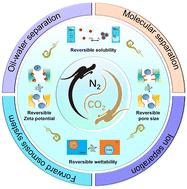二氧化碳响应膜分离系统:高效分离的绿色解决方案
IF 9.2
1区 化学
Q1 CHEMISTRY, MULTIDISCIPLINARY
引用次数: 0
摘要
膜分离技术以其绿色、环保、高效、连续化等特点,已成为现代分离过程中不可缺少的技术。它在制药、矿物提取和水净化方面有着广泛的应用。由于高效和稳定的分离过程往往需要跨孤立的、功能不同的区域的组分的整合,以及分离结果的协同实现,膜系统已经成为膜分离领域的一个突出趋势。其中,二氧化碳响应材料因其绿色驱动方式、温和绿色工况、不积累、可逆性优异而具有精确高效的分离性能,是一个重要的研究热点。本文综述了二氧化碳响应膜分离系统的发展历史,包括其二氧化碳响应机制、制备方法、关键表征技术和潜在应用。最后,对未来的研究方向进行了总结,并指出了二氧化碳响应膜分离系统面临的挑战和潜在的应用前景。本文章由计算机程序翻译,如有差异,请以英文原文为准。

CO2-responsive membrane separation systems: a green solution for efficient separations†
Membrane separation technology, which is characterized by its green, environmentally friendly, efficient, and continuous operation, has become indispensable in modern separation processes. It has widespread applications in pharmaceuticals, mineral extraction, and water purification. Because efficient and stable separation processes often require the integration of components across isolated, functionally distinct regions and the synergistic achievement of separation outcomes, membrane systems have emerged as a prominent trend within the field of membrane separation. Among them, CO2-responsive materials are an important research hotspot because of their precise and efficient separation performance caused by their green driving mode, mild and green condition, non-accumulation, and excellent reversibility. This review comprehensively investigates the history of the development of CO2-responsive membrane separation systems, including their CO2-responsive mechanisms, fabrication methods, critical characterization techniques, and potential applications. The review culminates in a forward outlook, summarizing future research directions as well as highlighting challenges in CO2-responsive membrane separation systems and emerging potential applications.
求助全文
通过发布文献求助,成功后即可免费获取论文全文。
去求助
来源期刊

Green Chemistry
化学-化学综合
CiteScore
16.10
自引率
7.10%
发文量
677
审稿时长
1.4 months
期刊介绍:
Green Chemistry is a journal that provides a unique forum for the publication of innovative research on the development of alternative green and sustainable technologies. The scope of Green Chemistry is based on the definition proposed by Anastas and Warner (Green Chemistry: Theory and Practice, P T Anastas and J C Warner, Oxford University Press, Oxford, 1998), which defines green chemistry as the utilisation of a set of principles that reduces or eliminates the use or generation of hazardous substances in the design, manufacture and application of chemical products. Green Chemistry aims to reduce the environmental impact of the chemical enterprise by developing a technology base that is inherently non-toxic to living things and the environment. The journal welcomes submissions on all aspects of research relating to this endeavor and publishes original and significant cutting-edge research that is likely to be of wide general appeal. For a work to be published, it must present a significant advance in green chemistry, including a comparison with existing methods and a demonstration of advantages over those methods.
 求助内容:
求助内容: 应助结果提醒方式:
应助结果提醒方式:


